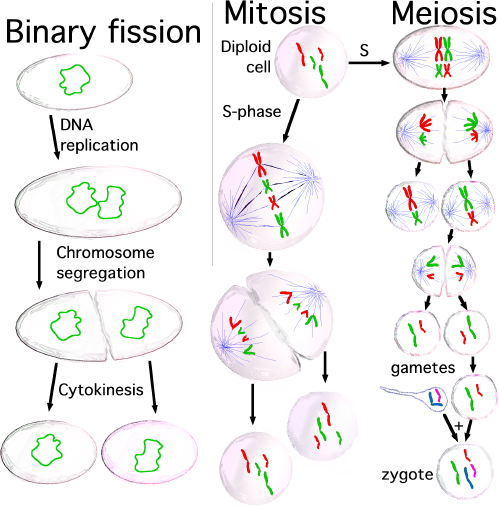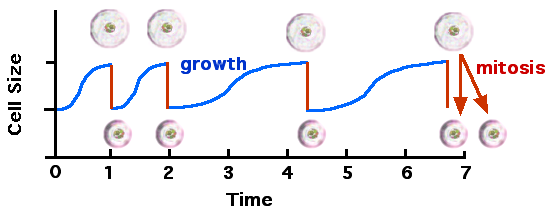Cell growth
|
WikiDoc Resources for Cell growth |
|
Articles |
|---|
|
Most recent articles on Cell growth Most cited articles on Cell growth |
|
Media |
|
Powerpoint slides on Cell growth |
|
Evidence Based Medicine |
|
Clinical Trials |
|
Ongoing Trials on Cell growth at Clinical Trials.gov Clinical Trials on Cell growth at Google
|
|
Guidelines / Policies / Govt |
|
US National Guidelines Clearinghouse on Cell growth
|
|
Books |
|
News |
|
Commentary |
|
Definitions |
|
Patient Resources / Community |
|
Patient resources on Cell growth Discussion groups on Cell growth Patient Handouts on Cell growth Directions to Hospitals Treating Cell growth Risk calculators and risk factors for Cell growth
|
|
Healthcare Provider Resources |
|
Causes & Risk Factors for Cell growth |
|
Continuing Medical Education (CME) |
|
International |
|
|
|
Business |
|
Experimental / Informatics |
Editor-In-Chief: C. Michael Gibson, M.S., M.D. [1]
The term cell growth is used in two different ways in biology.
When used in the context of reproduction of living cells the phrase "cell growth" is shorthand for the idea of "growth in cell populations by means of cell reproduction." During cell reproduction one cell (the "mother" cell) divides to produce two daughter cells.
Cell populations
Cell populations go through a type of exponential growth called doubling. Thus, each generation of cells should be twice as numerous as the previous generation. However, as noted by Richard Dawkins (1997), this view is naive as the number of generations only gives a maximum figure. This is due to the fact that not all cells survive in each generation.
Cell size
Yeast cell size regulation
The relationship between cell size and cell division has been extensively studied in yeast. For some cells, there is a mechanism by which cell division is not initiated until a cell has reached a certain size. If the nutrient supply is restricted (after time t = 2 in the diagram, below) and the rate of increase in cell size is slowed, the time period between cell divisions is increased. Yeast cell size mutants were isolated that begin cell division before reaching the normal size (wee mutants)[1]. The Wee1 protein is a tyrosine kinase. It normally phosphorylates the Cdc2 cell cycle regulatory protein (cyclin-dependent kinase-1, CDK1) on a tyrosine residue. This covalent modification of the molecular structure of Cdc2 inhibits the enzymatic activity of Cdc2 and prevents cell division. In Wee1 mutants, there is less Wee1 activity and Cdc2 becomes active in smaller cells, causing cell division before the yeast cells reach their normal size. Cell division may be regulated in part by dilution of Wee1 protein in cells as they grow larger.
Cell size regulation in mammals
The protein mTOR is a serine/threonine kinase that regulates translation and cell division[2]. Nutrient availability influences mTOR so that when cells are not able to grow to normal size they will not undergo cell division. The details of the molecular mechanisms of mammalian cell size control are currently being investigated. The size of post-mitotic neurons depends on the size of the cell body, axon and dendrites. In vertebrates, neuron size is often a reflection of the number of synaptic contacts onto the neuron or from a neuron onto other cells. For example, the size of motoneurons usually reflects the size of the motor unit that is controlled by the motoneuron. Invertebrates often have giant neurons and axons that provide special functions such as rapid action potential propagation. Mammals also use this trick for increasing the speed of signals in the nervous system, but they can also use myelin to accomplish this, so most human neurons are releatively small.
Other experimental systems for the study of cell size regulation
One common means to produce very large cells is by cell fusion to form syncytia. For example, very long (several inches) skeletal muscle cells are formed by fusion of thousands of myocytes. Genetic studies of the fruit fly Drosophila have revealed several genes that are required for the formation of multinucleated muscle cells by fusion of myoblasts[3]. Some of the key proteins are important for cell adhesion between myocytes and some are involved in adhesion-dependent cell-to-cell signal transduction that allows for a cascade of cell fusion events.
Oocytes can be unusually large cells in species for which embryonic development takes place away from the mother's body. Their large size can be achieved either by pumping in cytosolic components from adjacent cells through cytoplasmic bridges (Drosophila) or by internalization of nutrient storage granules (yolk granules) by endocytosis (frogs).
Increases in the size of plant cells is complicated by the fact that almost all plant cells are inside of a solid cell wall. Under the influence of certain plant hormones the cell wall can be remodeled, allowing for increases in cell size that are important for the growth of some plant tissues.
Most unicellular organisms are microscopic in size, but there are some giant bacteria and protozoa that are visible to the naked eye. See: Table of cell sizes - Dense populations of a giant sulfur bacterium in Namibian shelf sediments - Large protists of the genus Chaos, closely related to the genus Amoeba
Cell reproduction
Cell reproduction is asexual.
The process of cell reproduction has three major parts. The first part of cell reproduction involves the replication of the parental cell's DNA. The second major issue is the separation of the duplicated DNA into two equally sized groups of chromosomes. The third major aspect of cell reproduction is the physical division of entire cells, usually called cytokinesis.
Cell reproduction is more complex in eukaryotes than in other organisms. Prokaryotic cells such as bacterial cells reproduce by binary fission, a process that includes DNA replication, chromosome segregation, and cytokinesis. Eukaryotic cell reproduction either involves mitosis or a more complex process called meiosis. Mitosis and meiosis are sometimes called the two "nuclear division" processes. Binary fission is similar to eukaryotic cell reproduction that involves mitosis. Both lead to the production of two daughter cells with the same number of chromosomes as the parental cell. Meiosis is used for a special cell reproduction process of diploid organisms. It produces four special daughter cells (gametes) which have half the normal cellular amount of DNA. A male and a female gamete can then combine to produce a zygote, a cell which again has the normal amount of chromosomes.
The rest of this article is a comparison of the main features of the three types of cell reproduction that either involve binary fission, mitosis, or meiosis. The diagram below depicts the similarities and differences of these three types of cell reproduction.

Comparison of the three types of cell reproduction
The DNA content of a cell is duplicated at the start of the cell reproduction process. Prior to DNA replication, the DNA content of a cell can be represented as the amount Z (the cell has Z chromosomes). After the DNA replication process, the amount of DNA in the cell is 2Z (multiplication: 2 x Z = 2Z). During Binary fission and mitosis the duplicated DNA content of the reproducing parental cell is separated into two equal halves that are destined to end up in the two daughter cells. The final part of the cell reproduction process is cell division, when daughter cells physically split apart from a parental cell. During meiosis, there are two cell division steps that together produce the four daughter cells.
After the completion of binary fission or cell reproduction involving mitosis, each daughter cell has the same amount of DNA (Z) as what the parental cell had before it replicated its DNA. These two types of cell reproduction produced two daughter cells that have the same number of chromosomes as the parental cell. After meiotic cell reproduction the four daughter cells have half the number of chromosomes that the parental cell originally had. This is the haploid amount of DNA, often symbolized as N. Meiosis is used by diploid organisms to produce haploid gametes. In a diploid organism such as the human organism, most cells of the body have the diploid amount of DNA, 2N. Using this notation for counting chromosomes we say that human somatic cells have 46 chromosomes (2N = 46) while human sperm and eggs have 23 chromosomes (N = 23). Humans have 23 distinct types of chromosomes, the 22 autosomes and the special category of sex chromosomes. There are two distinct sex chromosomes, the X chromosome and the Y chromosome. A diploid human cell has 23 chromosomes from that person's father and 23 from the mother. That is, your body has two copies of human chromosome number 2, one from each of your parents.
Immediately after DNA replication a human cell will have 46 "double chromosomes". In each double chromosome there are two copies of that chromosome's DNA molecule. During mitosis the double chromosomes are split to produce 92 "single chromosomes", half of which go into each daughter cell. During meiosis, there are two chromosome separation steps which assure that each of the four daughter cells gets one copy of each of the 23 types of chromosome.
Sexual reproduction
Main article: Evolution of sex
Though cell reproduction that uses mitosis can reproduce eukaryotic cells, eukaryotes bother with the more complicated process of meiosis because sexual reproduction such as meiosis confers a selective advantage. Notice that when meiosis starts, the two copies of chromosome number 2 are adjacent to each other. During this time, there can be genetic recombination events. Parts of the chromosome 2 DNA gained from one parent (red) will swap over to the chromosome 2 DNA molecule that received from the other parent (green). Notice that in mitosis the two copies of chromosome number 2 do not interact. It is these new combinations of parts of chromosomes that provide the major advantage for sexually reproducing organisms by allowing for new combinations of genes and more efficient evolution.
However, in organisms with more than one set of chromosomes at the main life cycle stage, sex may also provide an advantage because, under random mating, it produces homozygotes and heterozygotes according to the Hardy-Weinberg ratio.
References
- ↑ Wee1 mutants of S. pombe have small cell size and the homologous proteins in humans also regulate cell entry into mitosis; in Molecular Cell Biology Fourth Edition by Harvey Lodish, Arnold Berk, Lawrence S. Zipursky, Paul Matsudaira, David Baltimore and James Darnell (2000) Published by W. H. Freeman.
- ↑ Download full text PDF: "[http://www.ncbi.nlm.nih.gov/entrez/utils/lofref.fcgi?PrId=3036&uid=16100767&db=pubmed&url=http://www.cmj.hr/2005/46/4/16100767.pdf Deregulation of cell growth and malignant transformation]" by Sanda Sulic, Linda Dikic, Ivan Dikic and Sinisa Volarevic in Croatian Medical Journal (2005) Volume 46, pages 622-638. {{Entrez Pubmed|16100767}}.
- ↑ "A positive feedback loop between Dumbfounded and Rolling pebbles leads to myotube enlargement in Drosophila" by Sree Devi Menon, Zalina Osman, Kho Chenchill and William Chia in Journal of Cell Biology (2005) Volume 169, pages 909-920.
Additional Resources
- Morgan DO. (2007) "The Cell Cycle: Principles of Control" London: New Science Press.
- Climbing Mount Improbable (1997) Richard Dawkins. ISBN 0-393-31682-3
See also
- Bacterial growth
- Cancer
- Clone (genetics)
- Developmental biology
- Stem cell
- Cell cycle
- Binary fission
- Mitosis
- Meiosis
External links
de:Zellwachstum simple:Cell growth cell mitosis
